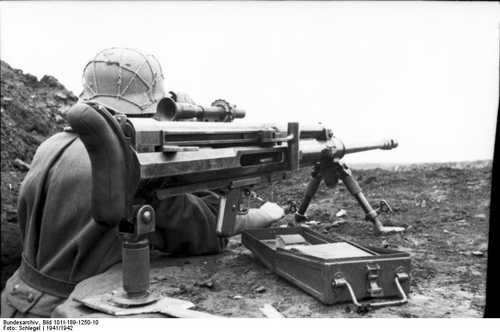From the web.
.55 inch Boys Anti Tank Rifle Mark 1
The Boys ATR was a large rifle with a padded rifle stock, pistol grip, an over-the-barrel magazine remiscent of the Bren machine gun and an integrated support leg which counts as a bipod. Named after one of its principal designers Captain Boys, this gun was the primary anti-tank weapon of British infantry until 1941, when it was replaced by the PIAT shaped charge weapons. It was widely used in campaigns against the Axis in France and North Africa in the early part of the war. While effective against the 1930s tanks it was designed to counter, it was - due to its bolt-action design - slow to operate and outclassed by later models such as the PzKpfw III. However the ATR could break the track of any tank.
"Quickly the men moved around few more corners in the trench. ‘We’ll set up right here !’ the anti-tank gunner ordered the lieutenant. They peeked over the brim of the trench. The second tank stood still, its turret rotating slowly. ‘It’s that one’s turn now,’ the man said with conviction.
When the turret had rotated so that the tank’s gunner could not see their location, the man barked: ‘Now !’
The men lifted the anti-tank rifle into position in a corner of the trench. It only took a second. The gunner hung onto the rear of the rifle and sighted on the target. That took a couple of seconds."
When the Winter War erupted in late 1939 international public sentiment was very much on the Finnish side. The British government donated two hundred Boys ATRs with the express wish that thirty of them would be given to Swedish volunteers. The rifles were a huge success against Soviet tanks of pre-war design which had been built to withstand small-arms fire only.
"Bang, bang, bang, bang the anti-tank rifle fired four times. Raetpalo’s ears were ringing viciously. Blue smoke hung above the corner in the trench. Loud smacks were heard from the direction of
the tank, proving that at least two rounds had struck it. Raetpalo peered at the tank. He could make out two holes in its side where the rounds had penetrated. Suddenly the hatches were flung open. The tank stood still, its engine having stalled, and it was slowly beginning to emit smoke. The engine came to life again at high revs and the volume of smoke increased, now almost completely hiding the tank. Slowly the machine began to crawl again, now headed back toward the Lähde road where it had come from.
’They’ve had enough. They’re fleeing !’ Raetpalo was overjoyed. After about a hundred meters there was a loud bang from the tank. It stopped and burst into flames. A smile of victory was on the lips of the tank killer - for that is what these anti-tank men were called - as he stated: ‘That was my sixth bullseye.’
Combat between a Boys gunner and a thirty-ton T-28 tank. Mannerheim Line, February 1940
In late 1940 Finland bought 200 Boys ATRs from German war booty stocks. The rifles were used on the front in the beginning of the Continuation War in 1941 but were for the most part withdrawn by 1943. The remaining 300 examples were kept in storage until the Fifties when they were sold to collectors.
A vet I knew who served in France 1940 said it was the most "lost" weapon in the British Army and troops used every oppurtunity to ditch it, mainly due to its weight and mighty kick when fired.


 Soldiers armed with ATRs were also taught the vulnerable places of enemy vehicles to aim for I’ve come across several such diagrams on the Internet, and I believe some war-gamers also use them for determining damage to AFVs. I’ll try to find one and post it. Also, IIRC, at least some ATRs were semi-automatic (the Japanese and Finns had such, and I think at least one of the major Solothurn models was also), so they could fire several shots “at once,” giving them better odds of making a critical hit in the spot they were aimed at. I hate to think of the recoil generated under such circumstances - a single shot ATR was bad enough! The Brits used to call the Boyes ATR by the nickname “Bastard Charlie.” The Finns also converted some of the semi-auto ATRs to full auto late in the war, for use as AA guns against low-flying targets.
Soldiers armed with ATRs were also taught the vulnerable places of enemy vehicles to aim for I’ve come across several such diagrams on the Internet, and I believe some war-gamers also use them for determining damage to AFVs. I’ll try to find one and post it. Also, IIRC, at least some ATRs were semi-automatic (the Japanese and Finns had such, and I think at least one of the major Solothurn models was also), so they could fire several shots “at once,” giving them better odds of making a critical hit in the spot they were aimed at. I hate to think of the recoil generated under such circumstances - a single shot ATR was bad enough! The Brits used to call the Boyes ATR by the nickname “Bastard Charlie.” The Finns also converted some of the semi-auto ATRs to full auto late in the war, for use as AA guns against low-flying targets.